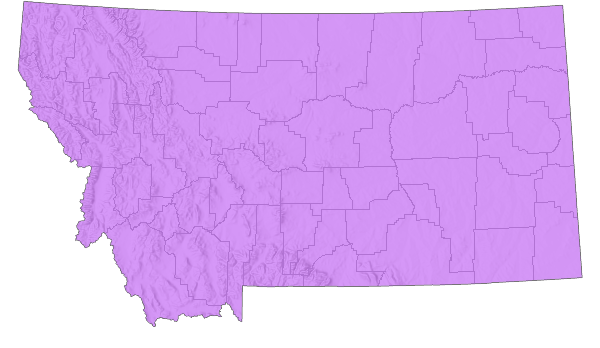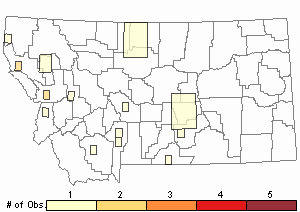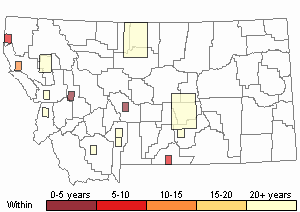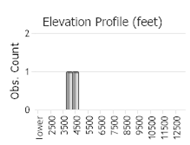View in other NatureServe Network Field Guides
NatureServe
Montana
Utah
Wyoming
Idaho
Wisconsin
British Columbia
South Carolina
Yukon
California
New York
Slender Meadow Katydid - Conocephalus fasciatus
General Description
The following is taken from Rehn and Hebard (1914), Blatchley (1920), Helfer (1971), Vickery and Kevan (1985), Bland (2003), Capinera et al. (2004), Elliott and Hershberger (2007), Himmelman (2009), and Scott (2010). The meadow katydids are sometimes called “long-horned grasshoppers” due to their long antennae. Meadow Katydids in the genus Conocephalus are small and generally called the “lesser meadow katydids with body lengths of 12-17 mm,” whereas those in the genus Orchelimum are larger in body form and referred to as the “greater meadow katydids” with body length of 18+ mm (not including the female ovipositor length for both genera).
As its name suggests, the Slender Meadow Katydid body is small, slender, and grass green with a dorsal brown stripe bordered by whitish-yellow down its back. The dorsal surface of the abdomen is colored with a yellowish wash. The wings extend well beyond the abdomen and hind femur. The female ovipositor is straight, slightly angled upward and with two-thirds of the tip tinged with reddish-brown.
Calling song description
Verbal descriptions are: (1) “The soft calling song of males is a buzz lasting 10 to 30 seconds, with faint ticks between buzzes” (Bland 2003). (2) “A series of soft, ‘locomotive-like’ ticks, followed by a sustained, sputtery trill” (Himmelman 2009). (3) “Soft sound, noticeable only a few feet away, usually less than two feet above the ground; 10-30 second buzzes, with 10 to 25 ticks between them; a tiny, slender, long-winged insect” (Alexander et al. 1972). (4) “To…find a singing male by homing in on his faint, high-pitched song is a challenge. Quiet, warm, sunny afternoons are the best time…Males are more easily collected by using an insect sweep net in areas of tall grass…An evenly spaced series of clicks or tsips followed by a faint, clicking purr or trill…” (Elliott and Hershberger 2007).
Phenology
This species overwinters in the egg stage. Adults occur from mid-July to mid-October, sometimes longer depending upon time of first killing frost. This species is the first among the katydid family to reach maturity and begin singing, and sometimes gathers in large singing colonies (Blatchley 1920, Vickery and Kevan 1985, and Himmelman 2009).
Diagnostic Characteristics
The following comes from Rehn and Hebard (1914), Blatchley (1920), Helfer (1971), Vickery and Kevan (1985), Bland (2003), Capinera et al. (2004), Elliott and Hershberger (2007), Himmelman (2009), and Scott (2010). The male body length is 12-13.5 mm, and for females 12-14.5 mm. Male pronotum (thorax) length is 3-3.5 mm, and for females 2.8-3.2 mm. The male tegmina (forewings) is 14-18 mm, and females 15-19 mm. The male hind femur length is 11-12 mm, and females 11.5-13 mm and ovipositor is 7.1-10.6 mm.
The three species of Meadow Katydids occurring in Montana are fairly easy to identify. The Slender Meadow Katydid is the smallest (also amongst all species in the katydid family) and the only one in the state with wings longer than the body. The most significant morphological characters for species ID are by examining and measuring the female ovipositors and comparing the male cerci. Refer to the illustration box.
Species Range
Montana Range
Range Descriptions

 Native
Native
Range Comments
The most widely distributed and frequently collected Conocephalus species in North America. It ranges from coast-to-coast in all 48 states and the across the southern third of all Canadian provinces. In Montana, it has been recorded for 20 counties, but probably occurs throughout the state (Vickery and Kevan 1985, Scott 2010, and Walker SINA website 2020).
Observations in Montana Natural Heritage Program Database
Number of Observations: 22
(Click on the following maps and charts to see full sized version)
Map Help and Descriptions
Relative Density

Recency



 (Observations spanning multiple months or years are excluded from time charts)
(Observations spanning multiple months or years are excluded from time charts)
Habitat
The Slender Meadow Katydid inhabits a variety of habitats in upland fields, roadsides, damp locations bordering wetlands, ponds, and along waterways where tall grasses and rank vegetation occurs. This species generally prefers damp locations (Vickery and Kevan 1985, Bland 2003, Capinera et al. 2004, and Himmelman 2009).
Food Habits
The Slender Meadow Katydid favors a mixed diet of grass flowers, seeds and insects. It has been observed feeding on small moth larvae and other small insects (Vickery and Kevan 1985, and Bland 2003).
Reproductive Characteristics
To date, no detailed studies nor observations specific to this species have been found within the published literature. For an excellent perspective of katydid and cricket reproductive behavior, refer to the volume by Darrell Gwynne (2001).
Stewardship Responsibility
References
- Literature Cited AboveLegend:
 View Online Publication
View Online Publication Alexander, R.D., A.E. Pace, and D. Otte. 1972. The singing insects of Michigan. The Great Lakes Entomologist 5(2):33-69.
Alexander, R.D., A.E. Pace, and D. Otte. 1972. The singing insects of Michigan. The Great Lakes Entomologist 5(2):33-69. Bland, R.G. 2003. The Orthoptera of Michigan—Biology, Keys, and Descriptions of Grasshoppers, Katydids, and Crickets. East Lansing, MI: Michigan State University Extension, Bulletin E-2815. 221 p.
Bland, R.G. 2003. The Orthoptera of Michigan—Biology, Keys, and Descriptions of Grasshoppers, Katydids, and Crickets. East Lansing, MI: Michigan State University Extension, Bulletin E-2815. 221 p. Blatchley, W. 1920. Orthoptera of Northeastern America, section Phaneropterinae pp. 459-494. In: Nature Publishing, Indianapolis, IN.
Blatchley, W. 1920. Orthoptera of Northeastern America, section Phaneropterinae pp. 459-494. In: Nature Publishing, Indianapolis, IN. Capinera, J.L., R.D. Scott, and T.J. Walker. 2004. Field Guide to Grasshoppers, Katydids, and Crickets of the United States. Ithaca, NY. Cornell University Press.
Capinera, J.L., R.D. Scott, and T.J. Walker. 2004. Field Guide to Grasshoppers, Katydids, and Crickets of the United States. Ithaca, NY. Cornell University Press. Elliott, L. and W. Hershberger. 2007. The songs of insects. New York, NY: Houghton Mifflin Harcourt. 227 p.
Elliott, L. and W. Hershberger. 2007. The songs of insects. New York, NY: Houghton Mifflin Harcourt. 227 p. Gwynne, D.T. 2001. Katydids and Bush-Crickets, Reproductive Behavior and Evolution of the Tettigoniidae. Ithaca, NY: Cornell University Press.
Gwynne, D.T. 2001. Katydids and Bush-Crickets, Reproductive Behavior and Evolution of the Tettigoniidae. Ithaca, NY: Cornell University Press. Helfer, J.R. 1971. How to Know the Grasshoppers, Crickets, Cockroaches, and Their Allies. Revised edition (out of print), Mineola, NY: Dover Publications.
Helfer, J.R. 1971. How to Know the Grasshoppers, Crickets, Cockroaches, and Their Allies. Revised edition (out of print), Mineola, NY: Dover Publications. Himmelman, J. 2009. Guide to Night-Singing Insects of the Northeast. Mechanicsburg, PA: Stackpole Books. 160 p.
Himmelman, J. 2009. Guide to Night-Singing Insects of the Northeast. Mechanicsburg, PA: Stackpole Books. 160 p. Rehn, J.A. and M. Hebard. 1914. Studies in American Tettigoniidae. Transactions of the American Entomological Society x1:271-344.
Rehn, J.A. and M. Hebard. 1914. Studies in American Tettigoniidae. Transactions of the American Entomological Society x1:271-344. Scott, R.D. 2010. Montana Grasshoppers, Katydids, and Crickets A Pictorial Field Guide to the Orthoptera. MagpieMTGraphics, Billings, MT.
Scott, R.D. 2010. Montana Grasshoppers, Katydids, and Crickets A Pictorial Field Guide to the Orthoptera. MagpieMTGraphics, Billings, MT. Vickery, V. R. and D. K. M. Kevan. 1985. The grasshopper, crickets, and related insects of Canada and adjacent regions. Biosystematics Research Institute, Ottawa, Ontario. Publication Number 1777. 918 pp.
Vickery, V. R. and D. K. M. Kevan. 1985. The grasshopper, crickets, and related insects of Canada and adjacent regions. Biosystematics Research Institute, Ottawa, Ontario. Publication Number 1777. 918 pp.
- Additional ReferencesLegend:
 View Online Publication
View Online Publication
Do you know of a citation we're missing? Cantrall IJ. 1943. The ecology of the Orthoptera and Dermaptera of the George Reserve, Michigan. Misc. Publications, Museum of Zoology, University of Michigan 54:1-182.
Cantrall IJ. 1943. The ecology of the Orthoptera and Dermaptera of the George Reserve, Michigan. Misc. Publications, Museum of Zoology, University of Michigan 54:1-182. Dethier, V.G. 1992. Crickets and Katydids, Concerts and Solos. Cambridge, MA: Harvard University Press. 140 p.
Dethier, V.G. 1992. Crickets and Katydids, Concerts and Solos. Cambridge, MA: Harvard University Press. 140 p. Fulton, B.B. 1933. Stridulating organs of female Tettigoniidae (Orthoptera). Entomological News XLIV:270-275.
Fulton, B.B. 1933. Stridulating organs of female Tettigoniidae (Orthoptera). Entomological News XLIV:270-275. Hebard, M. 1928. The Orthoptera of Montana. Proceedings of the Academy of Natural Sciences of Philadelphia, Vol. 80:211-306.
Hebard, M. 1928. The Orthoptera of Montana. Proceedings of the Academy of Natural Sciences of Philadelphia, Vol. 80:211-306. Himmelman, J. 2011. Cricket radio: tuning in the night-singing insects. Cambridge, MA: The Belknap Press of Harvard University Press. 272 p.
Himmelman, J. 2011. Cricket radio: tuning in the night-singing insects. Cambridge, MA: The Belknap Press of Harvard University Press. 272 p. Sater, S. 2022. The insects of Sevenmile Creek, a pictorial guide to their diversity and ecology. Undergraduate Thesis. Helena, MT: Carroll College. 242 p.
Sater, S. 2022. The insects of Sevenmile Creek, a pictorial guide to their diversity and ecology. Undergraduate Thesis. Helena, MT: Carroll College. 242 p. Walker T.J.(ed.). 2020. Singing insects of North America. Accessed 10 February 2021. https://orthsoc.org/sina/
Walker T.J.(ed.). 2020. Singing insects of North America. Accessed 10 February 2021. https://orthsoc.org/sina/
- Web Search Engines for Articles on "Slender Meadow Katydid"
- Additional Sources of Information Related to "Insects"





